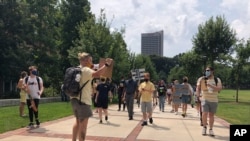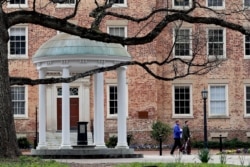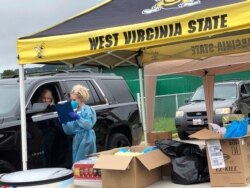Student Union
COVID-19 Infections Rising Among Young People on US University Campuses

Reports of COVID-19 cases are growing on university campuses as schools reopen for the fall semester.
The University of North Carolina at Chapel Hill quickly reversed its in-person classes as 135 positive COVID-19 cases, 130 students and five employees emerged after the first week of classes from Aug. 10 to Aug. 16.
“We have seen COVID-19 positive rate rise from 2.8% to 13.6% at Campus Health,” stated a letter posted on Monday to the university’s website.
Almost 1,000 (954) students have been tested, 177 are in isolation and 349 are in quarantine, both on and off campus, according to the letter. The university will shift all undergraduate in-person instruction to remote learning, effective Wednesday, Aug. 19.
Oklahoma State University announced Aug. 15 there were 23 positive COVID cases in an off-campus sorority house. The entire house is in isolation or quarantine and will be prohibited from leaving the facility.
The University of Wyoming also reported Monday 38 active cases among students and staff.
Two involve students living in the university’s residence halls, and the other 36 cases involve students and employees living off campus. Both groups are in isolation.
Boston University’s ‘COVID-19 Testing Data Dashboard’ showed eight positive tests cumulative from July 27.
The University of Notre Dame in Indiana also saw a spike in COVID-19 cases, reporting 59 confirmed positive cases out of 654 total tests since Aug. 3.
Notre Dame officials stated in a letter, “the vast majority of the positive cases appearing in the university’s dashboard this week can be traced to a SINGLE off-campus gathering.”
“The students involved were forthcoming in sharing information with contact tracers. They shared who they interacted with, when and for how long. They also indicated individuals at the gathering were both outside and inside, together for some time, not wearing masks, in a crowded space, and drinking,” it continued.
A New York Times survey of 270 higher education institutions uncovered 6,600 COVID-19 infections among students and staff, as well as 14 coronavirus-related deaths over the course of the pandemic.
In the list, the University of Texas at Austin recorded the most positive cases, with 449 from March 1 to July 28.
University of Central Florida came in second with 438 cases, and University of Georgia recorded 390.
Although many colleges and universities offer comprehensive reopening plans with mask-wearing and social distancing guidelines, research shows that even with such reinforcements the virus would still roam throughout campuses, causing complications.
Philip Gressman, a professor of mathematics at the University of Pennsylvania, and Jennifer Peck, an economics professor at Swarthmore College, created a simulation to “determine whether in-person instruction could safely continue during the pandemic and evaluate the necessity of various interventions.”
The simulation studied the spread of a highly transmissible virus, such as COVID-19, at reasonably large research university and monitored the efficacy of interventions, such as contact tracing, mask-wearing, online instruction, etc.
It consisted of 20,000 students and 2,500 instructors who interacted daily for 100 days.
The results of Gressman and Peck’s model analyzed that a scenario with no interventions from the university would result in the number of people initially infected doubling every 2.185 days.
In other words, more than 2,000 people would be infected within 30 days of the first infection, and about 20,126 people, or 89.4% of the total campus population, would end up infected.
The model also studied the outcome of standard intervention, which would be a combination of quarantine and contact tracing, universal mask-wearing, daily randomized testing of 3% of the university community, and transitioning all classes with 30 or more students to online-only interaction.
Full standard intervention measures in universities “avoid the epidemic tipping point altogether” and keeps cumulative infections below 66 (out of 22,500) in more than 95% of simulations, according to the study.
Gressman and Peck wrote that allowing large in-person courses would increase infections from 43 to 538, and online classes with more than 30 students was the most effective at keeping infection rates low.
Requiring masks was moderately effective: not requiring masks would increase median infections to 131, they wrote. Random testing and contact tracing had the lowest impact, with removing either measures increasing infections to 50 and 47, respectively.
Researchers Kim Weeden and Benjamin Cornwell from Cornell University in New York analyzed how students are interconnected on a college campus and the implications of resuming in-person instruction during the coronavirus pandemic.
Weeden and Cornwell’s study stated that students are “highly interconnected” through their courses and that the nature of enrollment networks makes student populations susceptible to high rates of transmissions.
See all News Updates of the Day
- By VOA News
Competition grows for international students eyeing Yale

It’s tough to gain admission to Yale University, and it’s getting even tougher for international students as standout students from around the world set their sights on Yale.
The Yale Dale News, the campus newspaper, takes a look at the situation here.
- By VOA News
Student from Ethiopia says Whitman College culture made it easy to settle in

Ruth Chane, a computer science major from Ethiopia, writes about her experiences settling into student life at Whitman College in the U.S. state of Washington.
"The community at Whitman College made sure I felt welcomed even before I stepped foot on campus," she says.
- By VOA News
Claremont Colleges student gets a shock when she heads home to Shanghai

In The Student Life, the student newspaper for the Claremont Colleges, a consortium of five liberal art colleges and two graduate schools in Claremont, California, student Rochelle Lu writes about readjusting to her Shanghai home after spending a semester in the United States.
- By VOA News
Cedarville University aims to ease transition for international students

Cedarville University in the U.S. state of Ohio says it’s got more than 140 international students representing 44 countries.
Here, the school interviews Jonathan Sutton, director of international student services. He talks about his job and the opportunities for international students on campus.
- By VOA News
Morehouse College offers prospective students tips on applying and thriving

Morehouse College, a private, historically Black liberal arts college in the U.S. state of Georgia, offers a guide for international students interested in attending the school.
Among the tips to apply and thrive at Morehouse:
- Take advantage of the school’s orientation program
- Turn to the school’s Center for Academic Success for tutoring, support and more
- Immerse yourself in campus life via clubs and societies
- By Reuters
US reviews Columbia University contracts, grants over antisemitism allegations

The administration of President Donald Trump said on Monday it will review Columbia University's federal contracts and grants over allegations of antisemitism, which it says the educational institution has shown inaction in tackling.
Rights advocates note rising antisemitism, Islamophobia and anti-Arab bias since U.S. ally Israel's devastating military assault on Gaza began after Palestinian Hamas militants' deadly October 2023 attack.
The Justice Department said a month ago it formed a task force to fight antisemitism. The U.S. Departments of Health and Education and the General Services Administration jointly made the review announcement on Monday.
"The Federal Government's Task Force to Combat Anti-Semitism is considering Stop Work Orders for $51.4 million in contracts between Columbia University and the Federal Government," the joint statement said.
The agencies said no contracting actions had been taken yet.
"The task force will also conduct a comprehensive review of the more than $5 billion in federal grant commitments to Columbia University."
The agencies did not respond to requests for comment on whether there were similar reviews over allegations of Islamophobia and anti-Arab bias.
Columbia had no immediate comment. It previously said it made efforts to tackle antisemitism.
College protests
Trump has signed an executive order to combat antisemitism and pledged to deport non-citizen college students and others who took part in pro-Palestinian protests.
Columbia was at the center of college protests in which demonstrators demanded an end to U.S. support for Israel due to the humanitarian crisis caused by Israel's assault on Gaza. There were allegations of antisemitism and Islamophobia in protests and counter-protests.
During last summer's demonstrations around the country, classes were canceled, some university administrators resigned and student protesters were suspended and arrested.
While the intensity of protests has decreased in recent months, there were some demonstrations last week in New York after the expulsion of two students at Columbia University-affiliated Barnard College and after New York Governor Kathy Hochul ordered the removal of a Palestinian studies job listing at Hunter College.
A third student at Barnard College has since been expelled, this one related to the occupation of the Hamilton Hall building at Columbia last year.
Canada’s immigration overhaul signals global shift in student migration
From Europe to North America, nations are tightening their immigration policies. Now Canada, long seen as one of the world's most welcoming nations, has introduced sweeping changes affecting international students. The reforms highlight a growing global trend toward more restrictive immigration policies. Arzouma Kompaore reports from Calgary.
Trump administration opens antisemitism inquiries at 5 colleges, including Columbia and Berkeley

The Trump administration is opening new investigations into allegations of antisemitism at five U.S. universities including Columbia and the University of California, Berkeley, the Education Department announced Monday.
It's part of President Donald Trump's promise to take a tougher stance against campus antisemitism and deal out harsher penalties than the Biden administration, which settled a flurry of cases with universities in its final weeks. It comes the same day the Justice Department announced a new task force to root out antisemitism on college campuses.
In an order signed last week, Trump called for aggressive action to fight anti-Jewish bias on campuses, including the deportation of foreign students who have participated in pro-Palestinian protests.
Along with Columbia and Berkeley, the department is now investigating the University of Minnesota, Northwestern University and Portland State University. The cases were opened using the department's power to launch its own civil rights reviews, unlike the majority of investigations, which stem from complaints.
Messages seeking comment were left with all five universities.
A statement from the Education Department criticized colleges for tolerating antisemitism after Hamas' Oct. 7, 2023, attack on Israel and a wave of pro-Palestinian protests that followed. It also criticized the Biden administration for negotiating "toothless" resolutions that failed to hold schools accountable.
"Today, the Department is putting universities, colleges, and K-12 schools on notice: this administration will not tolerate continued institutional indifference to the wellbeing of Jewish students on American campuses," said Craig Trainor, the agency's acting assistant secretary for civil rights.
The department didn't provide details about the inquiries or how it decided which schools are being targeted. Presidents of Columbia and Northwestern were among those called to testify on Capitol Hill last year as Republicans sought accountability for allegations of antisemitism. The hearings contributed to the resignation of multiple university presidents, including Columbia's Minouche Shafik.
An October report from House Republicans accused Columbia of failing to punish pro-Palestinian students who took over a campus building, and it called Northwestern's negotiations with student protesters a "stunning capitulation."
House Republicans applauded the new investigations. Representative Tim Walberg, chair of the Education and Workforce Committee, said he was "glad that we finally have an administration who is taking action to protect Jewish students."
Trump's order also calls for a full review of antisemitism complaints filed with the Education Department since Oct. 7, 2023, including pending and resolved cases from the Biden administration. It encourages the Justice Department to take action to enforce civil rights laws.
Last week's order drew backlash from civil rights groups who said it violated First Amendment rights that protect political speech.
The new task force announced Monday includes the Justice and Education departments along with Health and Human Services.
"The Department takes seriously our responsibility to eradicate this hatred wherever it is found," said Leo Terrell, assistant attorney general for civil rights. "The Task Force to Combat Anti-Semitism is the first step in giving life to President Trump's renewed commitment to ending anti-Semitism in our schools."
- By VOA News
STEM, business top subjects for international students

The Times of India breaks down the most popular subjects for international students to study in the U.S.
STEM and business lead the pack. Read the full story here. (January 2025)
- By VOA News
Safety and visa difficulties among misconceptions about US colleges

U.S. News & World report addresses some of the misconceptions about U.S. colleges and universities, including the difficulty of getting a visa.
Read the full story here. (January 2025)
- By VOA News
Work opportunities help draw international students to US schools

US News & World Report details the three top factors in foreign students' decision to study in the U.S. They include research opportunities and the reputation of U.S. degrees. Read the full story here. (December 2024)
- By VOA News
British student talks about her culture shock in Ohio

A British student who did a year abroad at Bowling Green State University in Ohio talks about adjusting to life in America in a TikTok video, Newsweek magazine reports.
Among the biggest surprises? Portion sizes, jaywalking laws and dorm room beds.
Read the full story here. (December 2024)
- By VOA News
Harvard's Chan School tells international students what to expect

Harvard's T.H. Chan School of Public Health reaches out to international students by detailing the international student experience at the school.
Learn more about housing, life in Boston and more here.
- By Reuters
China unveils plan to build 'strong education nation' by 2035

China issued its first national action plan to build a "strong education nation" by 2035, which it said would help coordinate its education development, improve efficiencies in innovation and build a "strong country."
The plan, issued Sunday by the Communist Party's central committee and the State Council, aims to establish a "high quality education system" with accessibility and quality "among the best in the world."
The announcement was made after data on Friday showed China's population fell for a third consecutive year in 2024, with the number of deaths outpacing a slight increase in births, and experts cautioning that the downturn will worsen in the coming years.
High childcare and education costs have been a key factor for many young Chinese opting out of having children, at a time when many face uncertainty over their job prospects amid sluggish economic growth.
"By 2035, an education power will be built," the official Xinhua news agency said, adding that China would explore gradually expanding the scope of free education, increase "high-quality" undergraduate enrolment, expand postgraduate education, and raise the proportion of doctoral students.
The plan aims to promote "healthy growth and all-round development of students," making sure primary and secondary school students have at least two hours of physical activity daily, to effectively control the myopia, or nearsightedness, and obesity rates.
"Popularizing" mental health education and establishing a national student mental health monitoring and early warning system would also be implemented, it said.
It also aims to narrow the gap between urban and rural areas to improve the operating conditions of small-scale rural schools and improve the care system for children with disabilities and those belonging to agricultural migrant populations.
The plan also aims to steadily increase the supply of kindergarten places and the accessibility of preschool education.
- By VOA News
A look at financial aid options for international graduate students in US

The Open Notebook, a site focusing on educating journalists who cover science, has complied a list of U.S. graduate program financial aid information for international students.











